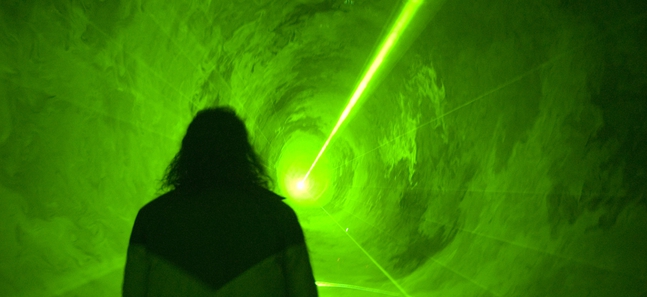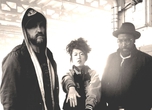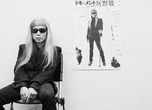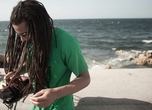Robin Fox: the interview
The laser-toting audiovisual artist prepares to give Tokyo a good zapping

Posted: Thu Sep 20 2012
Even the most forward-thinking VJs and visual artists might struggle to surpass the sheer 'wow' factor of one of Robin Fox's live shows. Inspired by his mother's synaesthesia – the condition in which different senses are interlinked, enabling people to 'see' sounds or 'taste' colours – the Australian artist and musician has spent over a decade experimenting with visualising sound. After starting out with an oscilloscope, he moved on to his current approach of using a bank of lasers, which synchronise perfectly with the music to create an effect that he describes as like 'standing inside an electrical signal'. The show has proved a hit on the international circuit: Fox performed at prestigious electronic music fest Mutek in Montreal this spring, and arrives in Tokyo this weekend on the back of a quick four-date tour of Europe.
There's more to this heavily bearded Melbourne resident than lasers, mind you. In the last few years, Fox has been engaged in a variety of pursuits, be it collaborating with contemporary dance company on works like the widely acclaimed Mortal Engine, developing music for cochlear implant wearers as part of the Music for the Bionic Ear project, or getting commissioned by Melbourne to build a giant theremin. Time Out got in touch with him by email, ahead of his appearance at the Extremities: JOLT Japanese Australian Sonic Festival at SuperDeluxe this Sunday.
We heard that you weren't legally able to perform your laser show in the US because of health and safety regulations. Is that true?
Ha! Well, yes, that is strictly speaking true. There are different regulations in different places. To the best of my knowledge so far, the show is illegal in the US, Sweden and Western Australia, as there are strict rules about not 'scanning' the audience with laser beams. There is an international set of safety guidelines that applies in most other places.
The idea of synaethesia comes up a lot in your work. Have you had much feedback from people who actually have the condition?
So far not too much. But interestingly, it's synaesthetes who are the most difficult audience for me. For those who already possess a cross-modal association between sound and colour or movement, my show will just seem 'wrong' to them. I try to simulate with hardware the conditions that might give rise to a synaesthetic experience, but it's not the real thing.
You've said before that you moved into using lasers because of limitations with performing with an oscilloscope. Could you see yourself ditching the laser for similar reasons in the future – and if so, what might you replace it with?
HOLOGRAMS!!! Real-time, living, fully three-dimensional holographic audio-visual experience. Lasers are incredibly directional!
In both your laser show and your giant theremin, there's an added dimension that's absent in something which 'merely' sounds amazing. Do you think that's key to their appeal? Can pure sound engender the same sense of wonder in an audience?
Wonder is a difficult thing to elicit. Sound can, in my experience, definitely induce [it]. The wonder induced – hopefully – by the laser show comes from the beautiful nature of focused light and the direct correlation between what you see and what you hear. The Giant Theremin was different: it was the sense of clear agency and the simple relationship between movement and sound that induced wonder there. So in both those works, the 'wonder' is mechanical. Sound can be wonderful. Of course it can.
The use of high-tech, immersive visuals has become much more common in the realms of dance music over the past few years. Is this something that you pay much attention to yourself?
When I started performing with the laser projector, there was a tendency to assume that I came out of the rave scene or something. I've never been to a rave. I work a lot in theatres, particularly with contemporary dance companies. I think the technology that got me going the most was Frieder Weiss's work on Mortal Engine. His infrared tracking and video effect system seems loaded with a great deal of potential. The big gig rigs are getting more and more hilarious; I hope to work with some of the large format screen and projection systems someday. I like the idea of large scale, full colour laser projection too.
How did you approach the Music for the Bionic Ear project? We hope it wasn't just a question of subjecting people with cochlear implants to lots of grim-faced listening sessions...
I was quite clinical in my approach to the Bionic Ear compositions. I commissioned other composers to write works for the project and they engaged more with the listening session model. I looked primarily at the cochlear implant hardware and tried to determine how I might 're-configure' music to fit that mechanical receptor. I made all of the music using synthesizers built in Max/MSP which could only play frequencies that directly correlated to the centre frequencies of the input filters of the implant itself.
You mentioned in your interview with The Quietus recently that you'd done a sound design on iPhones. Can you tell us about that?
Yes! That was great fun. It was for a work called 'Conversation Piece' by Melbourne-based choreographer Lucy Guerin, which involved three dancers and three actors. Cables fly in from the ceiling and iPhones are used both to play back tracks at various times, and also various apps are used to compose new things – and even play a Kylie Minogue track as an iPhone band. I'd like to try another composition using the phones if possible.
In your line of work, are there any specific benefits or disadvantages to being based in Australia?
Well, there is always the tyranny of distance! But the internet, for all its failings and evils, has definitely made the world a smaller place. I don't feel nearly as isolated as I did a few years ago. I like to work in the studio, in isolation, so I can do that anywhere. If anything, a recent disadvantage is that Melbourne has become incredibly expensive. I'd like more space!
Are there any particular artists who've informed your work, either when you were starting out or later on in your career?
The idea of influence is interesting: the older you get, the more you collect along the way. I remember pivotal moments in my music education like seeing 'Machine for Making Sense' (an Australian experimental ensemble) performing at my university. Also, conducting analyses of Boulez, Schoenberg and Webern at the same time that Aphex Twin released Come to Daddy. My first experience of Ryoji Ikeda's work, Bill Viola's video installations, reading Cage's writings, listening to Merzbow, etc. etc. But these are mixed with a deep, regressive psychotherapy-based love of '80s pop music, my bleak history as a failed heavy metal drummer, ten years of improv and all the other things that go into making up this thing we call 'life.'
Robin Fox performs at Extremities: JOLT Japanese Australian Sonic Festival, September 23 at SuperDeluxe
Tweets
- About Us |
- Work for Time Out |
- Send us info |
- Advertising |
- Mobile edition |
- Terms & Conditions |
- Privacy policy |
- Contact Us
Copyright © 2014 Time Out Tokyo














Add your comment